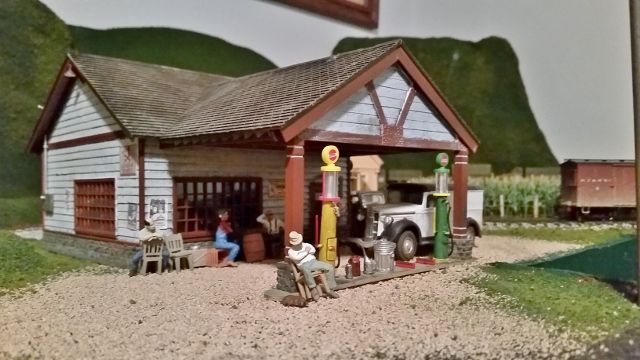I have acquired both Lionel structures (houses, commercial, industrial buildings) and Woodland Scenics buildings. The scales of these don't seem to adhere to O gauge scaling (1/48). The Lionel buildings seem smaller. I guess I could measure them and figure something out, but do any of you know what the scales of commercially available structures are from these two vendors as well as others?
Replies sorted oldest to newest
Only have one WS structure, the gas station.

I have several figures right out front and they look just right for the doors and windows. While I haven't broken out my scale ruler to measure part of it, the doors, gas pumps and other details on it look about right for O.
Williams,
Our buildings are 1/4 scale.
Check our website and feel free to contact us for any question.
Andre.
A lot of the buildings that Lionel constructed are scaled down to about 3/16 inches to the foot instead of 1/4-inch to the foot. Most kit manufacturers are using 1/4-inch to the foot scale.
Alan Graziano
Also, one should understand that many 1/48 structures are selectively compressed--especially industrial buildings. Selectively compressed buildings typically have one or more of their overall dimensions reduced (height, length, width). This does not change the scale.
Alan Graziano posted:Most kit manufacturers are using 1/4-inch to the foot scale.
Yes, but I have also found that more than few producers of kits fail to account for little tings like the thickness of floors and roofs and walls and such when they go and design a kit - might have 10' high rooms and floors that are 1/16" instead of what should probably be closer to at least 1/4". Doing that from the ground up and a kit for a house can be as much as 3/4" shorter than it should be - a form of selective compression. And then when you put a true 1/4 scale house next to it, things look "off".
I agree. The joist distance between floors is often overlooked. The height of a room could be reduced while maintaining a proper scale distance between the ceiling and the floor above it.
Inter-floor depth is at least 10" (with 1 X 8 floor joists and 1" subfloor, ceiling and flooring), and can be much more depending on the joist depth. I would stick with a scale foot like Al says. My scratch-built structures are all 1/4" = 1'. Traditional Lionel was sort of blend of S and O gauges, and then there was their crossing guard houses which were more like G gauge. Little kids didn't care so much.
Sometimes the exact scale isn't as important as the overall effect in combination with other layout factors such as limited space and conventionally undersized trains.
If we get particular about exact scale, there is no place for traditional 3-rail and tinplate trains.
Even with 1:48 scale trains on a 1:48 scale layout, selective compression is often desirable for a better effect in limited space. Undersized items may work well in the background for forced perspective.
Trainman2001 posted:Inter-floor depth is at least 10" (with 1 X 8 floor joists and 1" subfloor, ceiling and flooring), and can be much more depending on the joist depth. I would stick with a scale foot like Al says. My scratch-built structures are all 1/4" = 1'. Traditional Lionel was sort of blend of S and O gauges, and then there was their crossing guard houses which were more like G gauge. Little kids didn't care so much.
When I'm building stick by stick, I'm generally using 2x12's for joists or something very close.
I don't know, there are some three rail layouts to die for. Bob Bartizek's comes to mind. Ignore the three rails and his is a very scale looking empire. Now I understand about selective compression. Just our curves alone are selectively compressed to the nth degree. To really duplicate a mainline 1:1 curve we'd probably need O-300. Even the Pennsy had selective compression problems when the Baldwin Centipedes got stuck on the Zoo curve in Philly due to the radius being too tight. Life imitating art.


